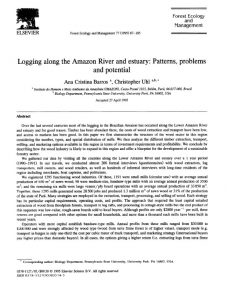| Título | Logging along the Amazon River and estuary: Patterns, problems and potential |
| Autores | Ana Cristina Barros (a) Christopher Uhl (b) |
| Vinculação dos autores | (a) Instituto do Homem e Meio Ambiente da Amazônia (Imazon) – Belém (PA), Brasil (b) Instituto do Homem e Meio Ambiente da Amazônia (Imazon) – Belém (PA), Brasil Biology Department, Pennsylvania State University, University Park, PA 16802, USA |
| Ano de publicação | 1995 |
| Meio de publicação | Forest Ecology and Management (Volume 77, Issues 1–3, September 1995, Pages 87-105) |
| DOI (Digital Object Identifier) | https://doi.org/10.1016/0378-1127(95)03574-T |
BARROS, A. C.; UHL, C. Logging along the Amazon River and estuary: Patterns, problems and potential. Forest Ecology and Management, v. 77, n. 1-3, p. 87-105, 1995.
 Abstract
Abstract
Over the last several centuries most of the logging in the Brazilian Amazon has occurred along the Lower Amazon River and estuary and for good reason. Timber has been abundant there, the costs of wood extraction and transport have been low, and access to markets has been good. In this paper we first characterize the structure of the wood sector in this region considering the number, types, and spatial distribution of mills. We then analyze the different timber extraction, transport, milling, and marketing options available in this region in terms of investment requirements and profitability. We conclude by describing how the wood industry is likely to expand in this region and offer a blueprint for the development of a sustainable torestry sector.
We gathered our data by visiting all the counties along the Lower Amazon River and estuary over a 1 year period (1990–1991). In our travels, we conducted almost 200 formal interviews (questionnaires) with wood extractors, log transporters, mill owners, and wood retailers, as well as hundreds of informal interviews with long-time residents of the region including merchants, boat captains, and politicians.
We registered 1295 functioning wood industries. Of these, 1191 were small mills (circular saw) with an average annual production of 650 m3 of sawn wood; 98 were medium-size, bandsaw-type mills with an average annual production of 3500 m3; and the remaining six mills were large veneer/ply board operations with an average annual production of 33 850 m3. Together, these 1295 mills generated some 28 500 jobs and produced 1.3 million m3 of sawn wood or 31% of the production of the state of Pará. Many strategies are employed in the extraction, transport, processing, and selling of wood. Each strategy has its particular capital requirements, operating costs, and profits. The approach that required the least capital entailed extraction of wood from floodplain forests, transport in log rafts, and processing in cottage-style mills but the end product of this sequence was low-value, rough-sawn boards sold to local buyers. Although profits are only $2800 year−1 per mill, these returns are good compared with other options for small households, and more than a thousand such mills have been built in recent years.
Operators with more capital establish bandsaw-type mills. Annual profits from these mills ranged from $30 000 to $200 000 and were strongly affected by wood type (wood from terra firme forest is of higher value), transport mode (e.g. transport in barges is only one-third the cost per cubic meter of truck transport), and marketing strategy (international buyers pay higher prices than domestic buyers). In all cases, the options giving a higher return (i.e. extracting logs from terra firme forests, barge transport, and international marketing) required more operating capital to initiate. The most capital intensive mills were the large veneer/plyboard mills. In compensation, annual profits for these operations approached one million dollars.
The potential for the expansion of the timber industry up the Amazon River is great, in large part because of the abundance of timber and the advantages offered by fluvial transport. But a special opportunity now exists for the development of sustainable forest management. The factors necessary for the development of sound forestry practices are uncontested dominion over forest resources for local people, well designed economic incentives that encourage management, and new bottom-up administrative models.
